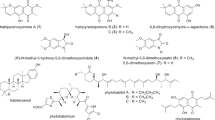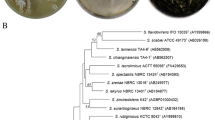Abstract
A phylogeny-guided approach was applied to screen endophytic fungi containing type I polyketide synthase (PKS I) biosynthetic gene sequences and aimed to correlate genotype to chemotype for the discovery of novel bioactive polyketides. Salicorn 58, which was identified as Talaromyces funiculosus based on its internal transcribed spacer (ITS) and ribosomal large-subunit (LSU) DNA sequences, showed significant target bands. A chemical investigation of the culture of Salicorn 58 was allowed for the isolation of a new polyketide, Talafun (1), and a new natural product, N-(2′-hydroxy-3′-octadecenoyl)-9-methyl-4,8-sphingadienin (2), together with six known compounds, including chrodrimanin A (3), chrodrimanin B (4), N-(4-hydroxy-2-methoxyphenyl) acetamide (5), butyl β-glucose (6), 3β,15β-dihydroxyl-(22E, 24R)-ergosta-5,8(14),22-trien-7-dione (7), and (3β,5a,8a,22E)-5,8-epidioxyergosta-6,22-dien-3-ol (8). Their chemical structures were elucidated by extensive spectroscopic analysis and electro circular dichroism (ECD) spectrum calculations. Antioxidant experiments revealed that compound 5 showed strong ABTS+ radical scavenging activity with an IC50 value of 11.43 ± 1.61 μM and potent ferric reducing activity (FRAP assay) with FRAP value of 187.52 ± 2.97. Antimicrobial assays revealed that compounds 1 and 4 showed high levels of selectivity toward Escherichia coli with MIC values of 18 ± 0.40 and 43 ± 0.52 μM, respectively. Compounds 2 and 3 exhibited broad-spectrum antimicrobial activity against Staphylococcus aureus, Mycobacterium smegmatis, Micrococcus tetragenus, Mycobacterium phlei, and E. coli, respectively. The results from the current research highlight the advantage of phylogeny-guided pipeline for the screening of new polyketides from endophytic fungi containing PKS I genes.






Similar content being viewed by others
References
Benzie IF, Strain JJ (1996) The ferric reducing ability of plasma (FRAP) as a measure of “antioxidant power”: the FRAP assay. Anal Biochem 239:70–76. doi:10.1006/abio.1996.0292
Dethoup T, Manoch L, Kijjoa A, Pinto M, Gales L, Damas AM, Silva A, Eaton G, Herz W (2007) Merodrimanes and other constituents from Talaromyces thailandiasis. J Nat Prod 70:1200–1202
Feng Z, Kallifidas D, Brady SF (2011) Functional analysis of environmental DNA-derived type II polyketide synthases reveals structurally diverse secondary metabolites. Pnas 108:12629–12634. doi:10.1073/pnas.1103921108/-/DCSupplemental
Gao H, Hong K, Zhang X, Liu H-W, Wang N-L, Zhuang L, Yao X-S (2007) New steryl esters of fatty acids from the mangrove fungus Aspergillus awamori. Helv Chim Acta 90:1165–1178. doi:10.1002/hlca.200790116
Gomez S, Cosson C, Deschamps AM (1997) Evidence for a bacteriocin-like substance produced by a new strain of Streptococcus sp., inhibitory to Gram-positive food-borne pathogens. Res Microbiol 148:757–766. doi:10.1016/s0923-2508(97)82451-5
Guo LD, Huang GR, Wang Y, He WH, Zheng WH, Hyde KD (2003) Molecular identification of white morphotype strains of endophytic fungi from Pinus tabulaeformis. Mycol Res 107:680–688. doi:10.1017/s0953756203007834
Bingle LEH, Simpson TJ, Lazarus CM (1999) Ketosynthase domain probes identify two subclasses of fungal polyketide synthase genes. Fungal Genet Biol 26:209–223. doi:10.1006/fgbi.1999.1115
Hayashi H, Oka Y, Kai K, Akiyama K (2012) New chrodrimanin congeners, chrodrimanins D-H, from YO-2 of Talaromyces sp. Biosci Biotech Bioch 76:1765–1768. doi:10.1271/bbb.120365
Jumpathong J, Seshime Y, Fujii I, Peberdy J, Lumyong S (2011) Genome screening for reducing type I polyketide synthase genes in tropical fungi associated with medicinal plants. World J Microb Biot 27:1989–1995. doi:10.1007/s11274-011-0659-9
Kahlos K, Kangas L, Hiltunen R (1989) Ergosterol peroxide, an active compound from Inonotus radiatus. Planta Med 55:389–390. doi:10.1055/s-2006-962036
Kang H-S, Brady FS (2014a) Mining soil metagenomes to better understand the evolution of natural product structural diversity-pentangular polyphenols as a case study. J Am Chem Soc 136:18111–18119. doi:10.1021/ja510606j
Kang HS, Brady SF (2014b) Arixanthomycins A-C: phylogeny-guided discovery of biologically active eDNA-derived pentangular polyphenols. ACS Chem Biol 9:1267–1272. doi:10.1021/cb500141b
Katalinic V, Modun D, Music I, Boban M (2005) Gender differences in antioxidant capacity of rat tissues determined by 2,2′-azinobis (3-ethylbenzothiazoline 6-sulfonate; ABTS) and ferric reducing antioxidant power (FRAP) assays. Comp Biochem Phys C: CBP 140:47–52. doi:10.1016/j.cca.2005.01.005
Kroken S, Glass NL, Taylor JW, Yoder OC, Turgeon BG (2003) Phylogenomic analysis of type I polyketide synthase genes in pathogenic and saprobic ascomycetes. P Natl Acad Sci 100:15670–15675. doi:10.1073/pnas.2532165100
Kroon PA, Williamson G, Fish NM, Archer DB, Belshaw NJ (2000) A modular esterase from Penicillium funiculosum which releases ferulic acid from plant cell walls and binds crystalline cellulose contains a carbohydrate binding module. Eur J Biochem 267:6740–6752. doi:10.1046/j.1432-1033.2000.01742.x
Lin CN, Tome WP, Won SJ (1991) Novel cytotoxic principles of Formosan Ganoderma lucidum. J Nat Prod 54(4):998–1002. doi:10.1021/np50076a012
Liu K, Ding X, Deng B, Chen W (2009) Isolation and characterization of endophytic taxol-producing fungi from Taxus chinensis. J Ind Microbiol Biotechnol 36:1171–1177. doi:10.1007/s10295-009-0598-8
Meikrantz W, Feldman RP, Sladicka MM, Ho D, Krupnick J, Anderson K, Schlegel RA (1991) Isolation of mitotic p34cdc2 apoenzyme from human cells. Fed Eur Biochem Soc 291:192–194. doi:10.1016/0014-5793(91)81281-C
Metsa-Ketela M, Salo V, Halo L, Hautala A, Hautala A, Mantsala P, Ylihonko K (1999) An efficient approach for screening minimal PKS genes from Streptomyces. FEMS Microbiol Lett 180:1–6. doi:10.1111/j.1574-6968.1999.tb08770.x
Mori K, Uenishi K (1996) Synthesis of (2S,2′ R ,3 R ,3′ E,4E,8E)-1-o-(β-D-Glucopyranosyl)-N-(2′- hydroxy-3′-octadecenoyl)-9-methyl-4,8-sphingadienine (Pen II), the major cerebroside isolated from Penicillium funiculosum as the fruiting-inducer against Schizophyllum commune. Liebigs Ann:1–6
Nugroho AE, Morita H (2014) Circular dichroism calculation for natural products. J Nat Med 68:1–10. doi:10.1007/s11418-013-0768-x
O’Donnell, K (1993) Fusarium and its near relatives. In: Reynolds DR, Taylor JW (eds)The fun- gal holomorph: mitotic, meiotic and pleomorphic speciation in fungal systematics. CAB International, Wallingford, UK, pp 225–233
Rojas JD, Sette LD, de Araujo WL, Lopes MS, da Silva LF, Furlan RL, Padilla G (2012) The diversity of polyketide synthase genes from sugarcane-derived fungi. Microbial Ecol 63:565–577. doi:10.1007/s00248-011-9938-0
Samson RA, Yilmaz N, Houbraken J, Spierenburg H, Seifert KA, Peterson SW, Varga J, Frisvad JC (2011) Phylogeny and nomenclature of the genus Talaromyces and taxa accommodated in Penicillium subgenus Biverticillium. Stud Mycol 70:159–183. doi:10.3114/sim.2011.70.04
Strobel GA (2003) Endophytes as sources of bioactive products. Microbes Infect 5:535–544. doi:10.1016/s1286-4579(03)00073-x
Tamura K, Peterson D, Peterson N, Stecher G, Nei M, Kumar S (2011) MEGA5: molecular evolutionary genetics analysis using maximum likelihood, evolutionary distance, and maximum parsimony methods. Mol Biol Evol 28:2731–2739. doi:10.1093/molbev/msr121
Wang F, Fang Y, Zhang M, Lin A, Zhu T, Gu Q, Zhu W (2008) Six new ergosterols from the marine-derived fungus Rhizopus sp. Steroids 73:19–26. doi:10.1016/j.steroids.2007.08.008
Wang H, Liu T, Xin Z (2014a) A new glucitol from an endophytic fungus Fusarium equiseti Salicorn 8. Eur Food Res Technol 239:365–376. doi:10.1007/s00217-014-2230-z
Wang X, Wang H, Liu T, Xin Z (2014b) A PKS I gene-based screening approach for the discovery of a new polyketide from Penicillium citrinum Salicorn 46. Appl Microbiol Biotechnol 98:4875–4885. doi:10.1007/s00253-014-5572-3
Wang X, Zhang M, Zhao Y, Wang H, Liu T, Xin Z (2013) Pentadecyl ferulate, a potent antioxidant and antiproliferative agent from the halophyte Salicornia herbacea. Food Chem 141:2066–2074. doi:10.1016/j.foodchem.2013.05.043
Wei M-Y, Chen G-Y, Wang Y, Zhang X-L, Wang C-Y, Shao C-L (2011) Isolation, 1H, 13C NMR assignments, and crystal structure of chrodrimanin B from a marine fungus Aspergillus sp. Chem Nat Compd 47:571–573. doi:10.1007/s10600-011-9997-y
White TJ, Bruns T, Lee S, Taylor J (1990) Amplification and direct sequencing of fungal ribosomal RNA genes for phylogenetics. PCR protocols: a guide to methods and applications, Academic, pp 315–322
Wood TM, Mccrae SI, Macfarlane CC (1980) The isolation, purification and properties of the cellobiohydrolase component of Penicillium funiculosum cellulase. Biochem J 189:51–65. doi:10.1042/bj1890051
Xu Y, Furutani S, Ihara M, Ling Y, Yang X, Kai K, Hayashi H, Matsuda K (2015) Meroterpenoid chrodrimanins are selective and potent blockers of insect GABA-gated chloride channels. PLoS One 10:e0122629. doi:10.1371/journal.pone.0122629
Zhang Y, Wang T, Pei Y, Hua H, Feng B (2001) Studies on chemical constituents of the fermentation liquor of soil fungus 07-11. J Pharm Sci 10:190–192
Zhao Y, Wang H, Liu T, Xin Z (2013) The individual lipid compositions produced by Cunninghamella sp. Salicorn 5, an endophytic oleaginous fungus from Salicornia bigelovii Torr. Eur Food Res Technol 238:621–633. doi:10.1007/s00217-013-2141-4
Zheng C-J, Xu L-L, Li Y-Y, Han T, Zhang Q-Y, Ming Q-L, Rahman K, Qin L-P (2013) Cytotoxic metabolites from the cultures of endophytic fungi from Panax ginseng. Appl Microbiol Biotechnol 97:7617–7625. doi:10.1007/s00253-013-5015-6
Zhou H, Li L, Wang W, Che Q, Li D, Gu Q, Zhu T (2015) Chrodrimanins I and J from the antarctic moss-derived fungus Penicillium funiculosum GWT2-24. J Nat Prod 78:1442–1445. doi:10.1021/acs.jnatprod.5b00103
Acknowledgments
This work was financially supported by the project funded by special funds of agro-product quality safety risk assessment of the Ministry of Agriculture of the People’s Republic of China (GJFP2015012).
Author information
Authors and Affiliations
Corresponding author
Ethics declarations
Human and animal rights
This article does not contain any studies with human or animal subjects.
Conflict of interest
The authors declare that they have no competing interests.
Electronic supplementary material
ESM 1
(PDF 733 kb)
Rights and permissions
About this article
Cite this article
Guo, J., Ran, H., Zeng, J. et al. Tafuketide, a phylogeny-guided discovery of a new polyketide from Talaromyces funiculosus Salicorn 58. Appl Microbiol Biotechnol 100, 5323–5338 (2016). https://doi.org/10.1007/s00253-016-7311-4
Received:
Revised:
Accepted:
Published:
Issue Date:
DOI: https://doi.org/10.1007/s00253-016-7311-4




